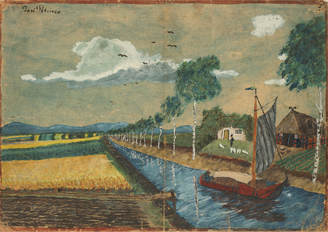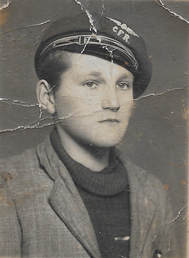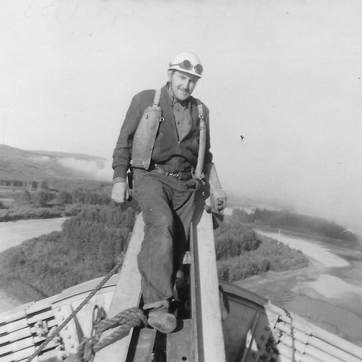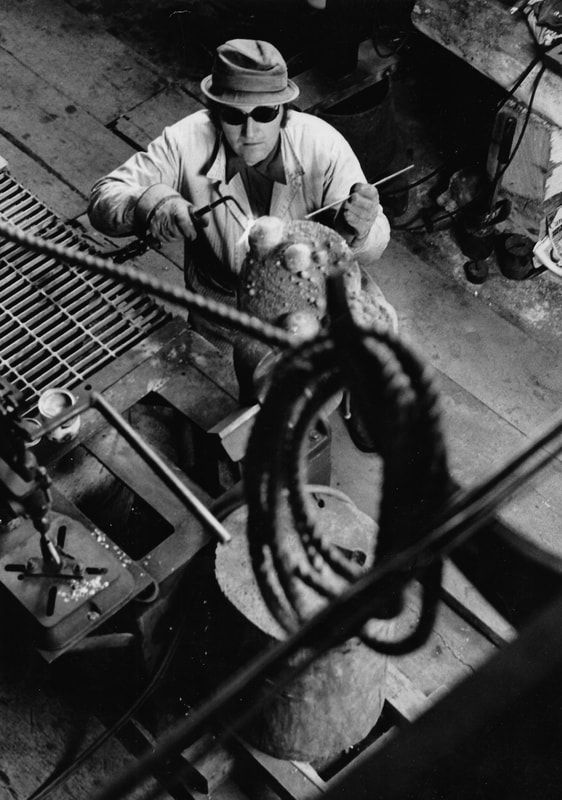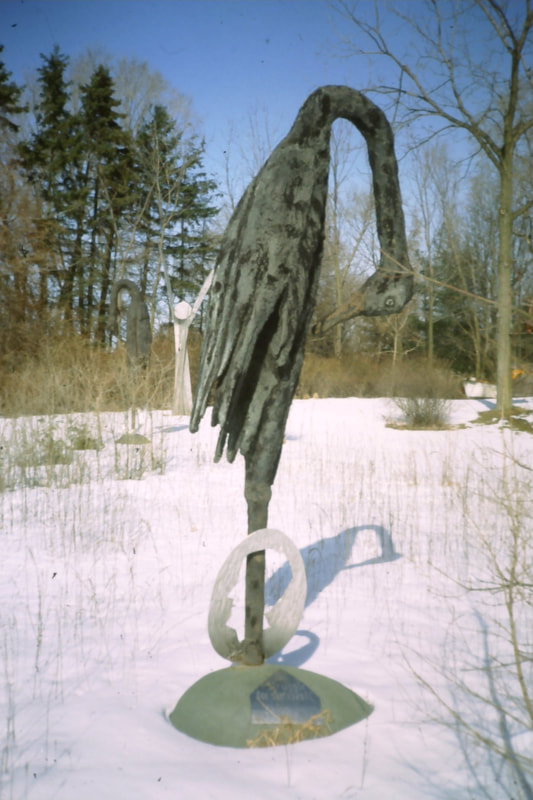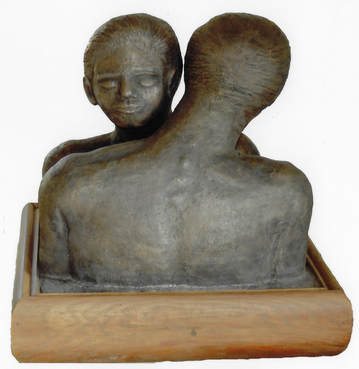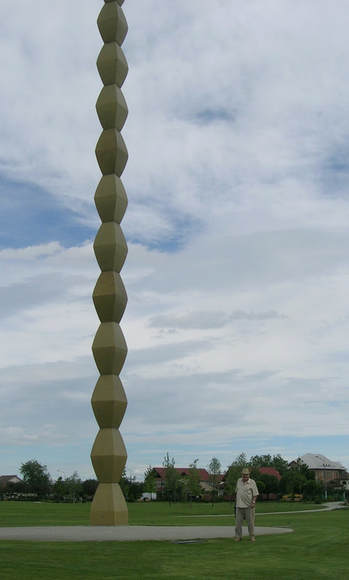|
Josef Petriska was born in Semlac, Western Romania on March 15, 1929. He was the son of a steel worker and one of 9 children. Josef was always good with his hands and in 1938, young Josef travelled with his school to watch the Romanian sculptor, Constantin Brâncuși, the Father of Modern Sculpture, install his 'Endless Column' in Targu Jiu. Completely captivated by watching Brâncuși work, Josef decided he also wanted to create and from then on, started experimenting and exploring his artistic abilities. His first commission was a 12 m x 12 m mural in Glogovat, Romania when he was 13 years old. Josef was attending technical school in Arad while World War 2 was in full effect. Josef and his oldest brother sold produce and meats to Nazi soldiers on trains passing back from Staingrad to raise some money for their family. They were often ejected from the moving trains in the process. Arad was bombed regularly during this period, and young Josef was exposed to the destruction and brutality of war. Two years after the Soviet invasion, Josef's mother feared for him because of his outspokenness, and urged him to flee Romania.
|
Water coloured painting of Felnac by Petriska at 10 years old, 1939
Josef in technical school, 1942, Arad, Romania
|
|
Josef crossing the Atlantic Ocean from Holland to Canada, on board the M.S. Sibijak, April 1952
|
Josef escaped Romania in 1947, but was caught and imprisoned in Hungary for 2 months. He was successful on his second attempt, passing through Czechoslovakia, Germany, then establishing himself in Holland. He spoke nine languages, and found work in construction. It was in Limburg, in 1949, where he first started noticing the damaging effects the coal industry had on the surrounding environment. This was the start of Josef Petriska's crusade to protect our environment. In April 1952, with help from his Czechoslovak friends, raised enough money to immigrate to Canada. Josef headed straight to Golden, British Columbia, to work in a hard rock mine. After being blinded briefly from a blast, Josef decided mining was not his calling and headed to Vancouver. Surrounded by the majestic Canadian wildness, Josef's artistic spark was rejuvenated and he returned to painting and creating sculptures.
|
|
Josef soon established himself as an ironworker and became one of the most sought after welders. He would take on the most dangerous and highest paying projects. He was part of the crew of the Second Narrows Bridge collapse in 1958, that killed 19 ironworkers and was also involved in stabilizing the bridge from further collapse. In 1966, Josef moved to Hollywood, California to start a business in the aerospace sector with his brother, and provided machined parts and components to the Jet Propulsion Laborartory. It was the hight of the Cold War and they struggled to keep up with the demands. It was during his time in California where Josef realized his calling in life. He witnessed first hand the Santa Barbara Oil Spill and then decided to dedicate his life to promoting environmental awareness by using his artwork as the medium to convey his messages. In 1969, Josef relocated to Oakville, Ontario.
|
Petriska dismantling the Peace River Bridge after its collapse, Taylor, British Columbia, 1958
|
|
Petriska sculpted in various metals, but mainly with silver nickel and bronze. He was commissioned by private corporations and government. In 1974, he converted a historic barn in South Oakville to his new studio. He made good use of the barns height and beams to hoist his large pieces.
Harry Howard's "L'Atiler", Josef's studio on Lakeshore Road in Oakville, Ontario
|
|
Josef exhibited his art in private and public locations within Canada and internationally, with many other well known Canadian artists, including members of the Group of Seven, Sorel Etrog, Robert Bateman, Karel Appel, just to name a few. While producing his sculptures and paintings, Josef relentlessly continued his campaign to promote environmental awareness, and his sculpture, "Sruggle for Survival" was the symbol for this campaign Petriska knew very well that the sight of a dropping, sickly bird was depressing, but he felt that this might just be what people needed to make them reconsider the treatment of their surroundings and the protection of our heritage. His campaign intensified after the death of his four year old daughter: "My little daughter, Tenley, four years old just two weeks prior to her death from that awful virus Reye's syndrome, asked me what I was doing with that sad bird. I explained to her at an adult level and she said that it is a worthwhile project." Josef's pusuit to promote "Struggle for Survival" drew national attention and was featured in several television program and newspaper articles across the country.
It was always an up hill battle, and during the 1980's, politicians, corporations, and the public did not want to be bothered with 'the environment' or the financial implications of being ecologically responsible, but Josef continued the crusade on his own. |
"I must emphasize however that 'Struggle for Survival' is not a business proposal with profits, etc, but an environmental logo, in three dimensions, which will serve us all as a prevention against further destruction of our environment."
- Josef Petriska, May 1980, letter to Ministry of Environment for support of his project.
- Josef Petriska, May 1980, letter to Ministry of Environment for support of his project.
|
In 1990, Josef decided to take his environmental concerns more publicly and decided run for the Green Party. He did not enjoy politics, so was pleased when he did not win, but had the chance to take his message to a larger audience. In 1992, Josef completed the painting "Our Choice", which was his next environmental plea for more caution and care. "Our Choice", depicting a spoiled environment next to a pristine space, was promoted again through government, industries and private organizations.
|
|
Josef continued to distribute his artwork and spread the message of environmental awareness through his artwork, notably "Our Choice" and tried to distribute this print in school systems, as well as through government agencies. His last sculpture he completed reflected upon his view of the growing disconnection and distant relationships humans are having among ourselves. He called it "Modern Embrace", and was 83 years old when it was completed in 2012.
"Even though we embrace, we never really touch"
- Josef Petriska, 2013 "Modern Embrance", 38", bronze & fibreglass
Josef passed away peacefully at home one week after his 86th birthday on March 23rd 2015, after a long battle with prostate cancer.
|
In 2007, Petriska returned to Romania, 60 years after he fled (Petriska next to Brâncuși's Endless Column).
|
